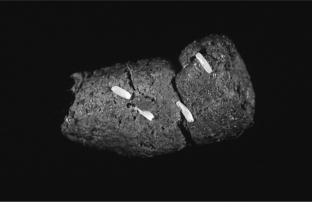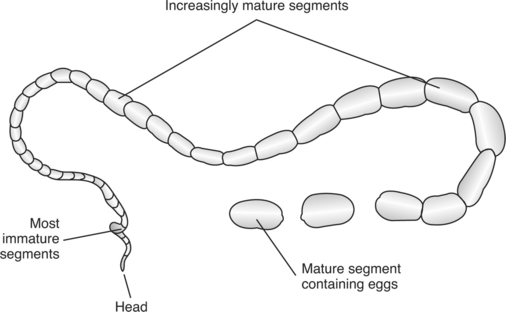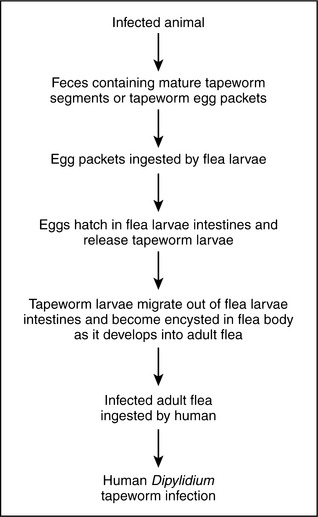TAPEWORMS (CESTODES)
Tapeworms are flat worms that live in the intestinal tracts of their hosts. Adult tapeworms cause little damage to their hosts beyond robbing the host of some micronutrients, such as vitamins. Adult tapeworms are visible to the naked eye and range in size from 0.04 inches to 50 feet long. An infection of tapeworms is called cestodiasis.
ETIOLOGY: PARASITIC
Adult tapeworms are found in the intestinal tracts of their definitive, or final, hosts. Each adult tapeworm consists of a head (scolex), which attaches the tapeworm to the intestinal wall, neck, and various numbers of segments, developing from the neck region. As new segments are formed at the neck, older segments are pushed back. Tapeworms are hermaphroditic; each segment has two sets of male and female reproductive organs, which will fill the segment with fertile eggs as the segment is pushed back from the neck. When the segment is full of eggs, it detaches itself from the adult tapeworm and is passed in the feces (Figure 40).
Each genus and species of tapeworm has at least one intermediate host, which ingests the tapeworm eggs. After the eggs hatch, the immature tapeworms migrate out of the intestine of the intermediate host and travel to various tissues in the body, depending on the genus of tapeworm. The immature tapeworm enters tissue in the intermediate host and is enclosed in a cyst, in which young tapeworms develop to an infective stage. Definitive hosts are infected by eating the cystic tissues of intermediate hosts infected with immature tapeworms.
TRANSMISSION
Adult tapeworm segments are passed in the host’s feces (Figure 41). These segments look like cucumber seeds or grains of rice and are sometimes seen around the anus of the host or in the feces. After the segments are passed, they can move around. They eventually dry up and release egg packets. The egg packets are then eaten by flea or louse larvae, and hatch in the larvae’s small intestines. The larval form of the tapeworm then penetrates the intestinal wall of its tiny host and forms cysts in the body cavity. As the flea or louse matures, the tapeworm larva matures, to an infective, cystic stage. The final host is infected by eating a flea or louse infected with immature tapeworms (Figure 42).

FIGURE 41 Tapeworm segments in dog feces
(From Hendrix CM, Robinson E: Diagnostic parasitology for veterinary technicians, ed 3, St Louis, 2006, Mosby.)
Stay updated, free articles. Join our Telegram channel

Full access? Get Clinical Tree




